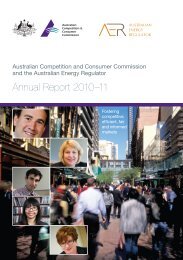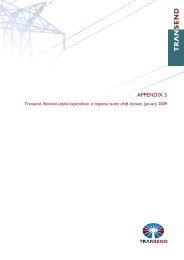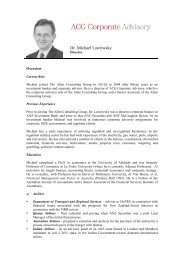Internal consistency of risk free rate and MRP in the CAPM
Internal consistency of risk free rate and MRP in the CAPM
Internal consistency of risk free rate and MRP in the CAPM
Create successful ePaper yourself
Turn your PDF publications into a flip-book with our unique Google optimized e-Paper software.
In fact, we know from earlier studies that <strong>the</strong> expected <strong>risk</strong> premium on <strong>the</strong><br />
market as well as conditional betas are not constant (Keim <strong>and</strong> Stambaugh<br />
(1986), Breen, Glosten, <strong>and</strong> Jagannathan (1989)), <strong>and</strong> vary over <strong>the</strong> bus<strong>in</strong>ess<br />
cycle (Fama <strong>and</strong> French (1989), Chen (1991), <strong>and</strong> Ferson <strong>and</strong> Harvey (1991)).<br />
41. Fama <strong>and</strong> French (1989) 8 cited by Jaganathan <strong>and</strong> Wang conclude:<br />
Our tests <strong>in</strong>dicate that expected excess returns (returns net <strong>of</strong> <strong>the</strong> one-month<br />
Treasury bill <strong>rate</strong>) on corpo<strong>rate</strong> bonds <strong>and</strong> stocks move toge<strong>the</strong>r. Dividend<br />
yields, commonly used to forecast stock returns, also forecast bond returns.<br />
Predictable variation <strong>in</strong> stock returns is, <strong>in</strong> turn, tracked by variables commonly<br />
used to measure default <strong>and</strong> term (or maturity) premiums <strong>in</strong> bond returns. The<br />
default-premium variable (<strong>the</strong> default spread) is <strong>the</strong> difference between <strong>the</strong> yield<br />
on a market portfolio <strong>of</strong> corpo<strong>rate</strong> bonds <strong>and</strong> <strong>the</strong> yield on Aaa bonds. The term-<br />
or maturity-premium variable (<strong>the</strong> term spread) is <strong>the</strong> difference between <strong>the</strong><br />
Aaa yield <strong>and</strong> <strong>the</strong> one-month bill <strong>rate</strong>.<br />
3.2. <strong>MRP</strong> will <strong>of</strong>ten move <strong>in</strong> <strong>the</strong> opposite direct <strong>in</strong>to <strong>the</strong> <strong>risk</strong> <strong>free</strong> <strong>rate</strong><br />
42. Moreover, <strong>the</strong>re is a general consensus that <strong>the</strong> market <strong>risk</strong> premium tends to move <strong>in</strong><br />
<strong>the</strong> opposite direction to <strong>the</strong> <strong>risk</strong> <strong>free</strong> <strong>rate</strong> – especially for material changes <strong>in</strong> <strong>the</strong> level<br />
<strong>of</strong> <strong>the</strong> <strong>risk</strong> <strong>free</strong> <strong>rate</strong>. For example, Lettau <strong>and</strong> Ludvigson 9 f<strong>in</strong>d that <strong>the</strong> <strong>risk</strong> premiums<br />
tend to move <strong>in</strong> <strong>the</strong> opposite direction to <strong>the</strong> de-trended government bond <strong>rate</strong>.<br />
43. Amongst o<strong>the</strong>r f<strong>in</strong>d<strong>in</strong>gs, <strong>the</strong>y found a strongly statistically significant negative<br />
relationship between <strong>the</strong> de-trended US bill <strong>rate</strong>s <strong>and</strong> <strong>the</strong> change <strong>in</strong> <strong>the</strong> log excess<br />
return (<strong>the</strong> variable <strong>the</strong>y <strong>in</strong>troduce ak<strong>in</strong> to <strong>the</strong> <strong>MRP</strong>). Such a negative relationship held<br />
true without controll<strong>in</strong>g for o<strong>the</strong>r potential variables that might affect <strong>risk</strong> premiums (i.e.<br />
a simple correlation suggested that <strong>the</strong> <strong>risk</strong> premiums rose 2.1% for every 1%<br />
reduction <strong>in</strong> <strong>the</strong> de-trended <strong>risk</strong> <strong>free</strong> <strong>rate</strong>). When Lettau <strong>and</strong> Ludvigson <strong>in</strong>cluded<br />
controls for o<strong>the</strong>r variables <strong>the</strong>y still found that when <strong>the</strong> de-trended <strong>risk</strong> <strong>free</strong> <strong>rate</strong> fell<br />
<strong>the</strong> <strong>risk</strong> premiums tended to rise by <strong>the</strong> same amount as <strong>the</strong> fall <strong>in</strong> <strong>the</strong> de-trended <strong>risk</strong><br />
<strong>free</strong> <strong>rate</strong>.<br />
44. Reflect<strong>in</strong>g this negative relationship, Smi<strong>the</strong>rs <strong>and</strong> Co, advisers to <strong>the</strong> UK economic<br />
regulators, have recommended that <strong>the</strong> cost <strong>of</strong> equity not be varied based on<br />
variations <strong>in</strong> <strong>the</strong> <strong>risk</strong> <strong>free</strong> <strong>rate</strong>:<br />
Given our preferred st<strong>rate</strong>gy <strong>of</strong> fix<strong>in</strong>g on an estimate <strong>of</strong> <strong>the</strong> equity return, any higher<br />
(or lower) desired figure for <strong>the</strong> safe <strong>rate</strong> would be precisely <strong>of</strong>fset by a lower<br />
8 Fama <strong>and</strong> French, 1989, Bus<strong>in</strong>ess Conditions And Expected Returns On Stocks And Bonds, Journal <strong>of</strong><br />
F<strong>in</strong>ancial Economics<br />
9 Lettau, Mart<strong>in</strong> <strong>and</strong> Sydney Ludvigson, 2001, “Consumption, Aggregate Wealth <strong>and</strong> Expected Stock Returns,”<br />
Journal <strong>of</strong> F<strong>in</strong>ance 56 (3), pp. 815—849.<br />
Competition Economists Group<br />
www.CEG-AP.COM<br />
8







